
Transcription
ImageJ for ASCOM: Tomography, Laue DiffractionImageJ-for-ASCOM is copyright but free; even if you don't have one of our cameras you can install itand try it with our camera simulator. It is best for the most difficult acquisitions, especially in low fluxconditions, from Tomography to Laue diffraction, even with multiple CCDs. It rivals powerfulcommercial applications, but is open source with simple scripts that can be customised for particularneeds. These scripts are hidden behind the GUI of ImageJ, which makes it easy for beginners, butthey can also be extended with a simple text editor. With automatic noise removal and averaging overmultiple exposures, this software brings out details that might otherwise be missed.For example, a script such as Orient.vbs (or any other Windows application) can be called at the endof each image acquisition and used to re-orient the sample for Tomographic imaging. Or images fromtwo CCDs in a Laue diffraction camera can be collected simultaneously, and automatically stitchedtogether to provide a larger composite image.ASCOM is an open AStronomy Component Object Model for the Windows COMenvironment.ImageJ is an open Image processing application for the Java environment, and widelyused by the scientific community. FITS (Flexible Image Transport System) is an image format forscientific applications.ImageJ for ASCOM: Installation and Programming Download and install ImageJ bundled with Java 32-bits for Windows to folder C:\Prefer the more compatible 32-bit version even if you have a 64-bit computerOr just copy the ImageJ folder from the software CCD to your C:\ root directory Download and install the ASCOM Platform 6 Download and install an ASCOM Driver or use the Simulator drivers in ASCOMFor slim USB NeutronOptics cameras use the Starlight Xpress ASCOM driverFor high-resolution NeutronOptics cameras use the Artemis ASCOM driverASCOM drivers are installed in C:\Program Files\Common Files\ASCOM\CameraFor 64-bit Windows, C:\Program Files(x86)\Common Files\ASCOM\CameraUse Control Panel/Programs to remove it. This is NOT the camera device driverThe ASCOM Profile Explorer can also be used to remove ASCOM driversYou must ALSO install the camera device driver that comes with the cameraYou can test your setup for an ASCOM Camera with the Nebulosity application
Download FITS.DLL to C:\Program Files\Common Files\ASCOM\Image\ Open a command window by clicking Start and typing CMD in the Start search boxthen press CTRL SHIFT ENTER for administrator control. As administrator, register FITS.dll by typing in the command window:REGSVR32 "C:\Program Files\Common Files\ASCOM\Image\FITS.dll" then ENTERFor 64-bit systems read "Program Files(x86)" instead of "Program Files" Download ASCap.vbs and Orient.vbs to C:\ImageJ\VBScripts\ Download ASCap.txt to C:\ImageJ\macros\toolsets\ASCap.txt Download fork.class to C:\ImageJ\plugins\fork.class (read fork.java for info) Re-launch ImageJ to pick up the newly installed ASCap.txt Macro Toolset Click the red icon on the ImageJ toolbar and select the ASCap tool Right-click the Camera Capture icon to select the camera & set capture optionsDon't select a second CCD unless you have a dual-CCD camera Left-click the Camera icon to capture a FITS image and display it with ImageJIf it doesn't work, check your image directory and see the problems section.Select the Camera using the ASCOM ChooserIf no camera has already been selected, theASCOM Camera Chooser will open.Select the Camera (or the Simulator).Don't forget to click on "Properties" if youwant to re-configure the camera.To select a different camera, reload the ASCapscript and right-click icon.Click the images to enlarge themIf necessary, set the Camera PropertiesCamera properties depend on cameraYou usually won't want to change themThis example is for the thin CCDLogging and dumping are for debuggingx2 binning to resolution for x4 intensityEqualise frames for interlaced camerasDo NOT use Gaussian Blur !!If you do, Despeckle filter won't workUse ImageJ for all image manipulationAs a general rule, collect raw data !
Set the Capture Options such as Exposure TimeRight-click the camera icon to input: The Directory to store FITS images The Image file root name The temperature (C) for cooled CCDsA blank temperature disables cooling The number of adjacent pixels to bin2x2 binning gives a x4 intensity gain The Exposure time (in seconds) The number of consecutive exposures Continuous exposure (ESC key to stop) Flip options for the image Despeckle filter removes hot pixels An automatic background correction Or Subtraction of a background image An optional turntable control file eg.to rotate the sample after each image. Set K1,K2 to correct for lens distortion K1 0 will disable lens correctionsTo enable optional lens corrections,install SplineDeformationGenerator. (seethe documentation). Double clickmySplineDeformationGenerator.zip& drag mySplineDeformationGenerator folderto the tor will appear inthe Plugins menu when you restart ImageJ.It will only be used if parameter K1 is set.The latest version of ASCap.txt retriesacquisition if an error is encountered. You caneven unplug and replug the USB data cableand sequential image collection will usuallycontinue.Capturing Images by left-clicking the camera iconAfter the camera and capture conditions are set by right-clicking the ImageJ camera icon, imagesmay be repeatedly captured and displayed simply by left-clicking the camera icon. If a number ofimages are captured sequentially, they are stored in a TIFF array and averaged. A sequentialexposure loop continues until the image window is closed or the Esc key is pressed. If the Alt key isheld down, the sequence terminates after averaging.
You can change the Capture Options by right-clicking the camera icon without re-selecting thecamera, and this is usually possible even during a sequential acquisition. ImageJ can of course beused to enhance the images in many ways. Read for example An Introduction to Astronomical ImageProcessing with ImageJ.The above image is for the Camera V2 simulator. For illustration purposes, the 16-bit FITS image iscompressed here to a simple JPEG screen captureTemperature Control and PlottingIf you have one of our cooled CCDs, you can set the temperature and plot it for each acquisition,along with the cooling power. The menus at the bottom of the plot display a List of temperatures andallows you to Save them. The More menu allows you to change the plot scale, the axis labels, zoomto a particular region etcI
Tomographic and Remote data collectionAt the end of each image acquisition, a Windows routine like Orient.vbs will be launchedautomatically (if it exists) to re-orient the sample. You can test the example Orient.vbs, but in practiceyou must edit it, or replace it with some other Windows application, depending on the control softwarefor your particular sample table, such as LabView.Although our cameras are supplied with 10m amplified USB extension cables, which you can chainup to 30m, you can also control your image acquisition using a Remote Desktop, from anothercomputer or even your mobile phone. Download and install your preferred Remote Desktop fromGoogle, Microsoft or Apple; we prefer Chrome Remote Desktop.A few useful ImageJ CommandsTo emphasize a specific image area, select it with the rectangle tool and click "auto"Brightness/Contrast (Ctrl Shift C). /- keys to zoom in or out Image/Transform/ to flip or rotate the image or bin adjacent pixels Image/Adjust/Brightness/Contrast (Ctrl-Shift-C) Brightness, Contrast, Min/Max Image/Stacks/Z-project to sum multiple images in a stack Process/ to Smooth, Sharpen or find Edges etc Process/Noise/Despeckle to remove isolated hot pixels Copy the de-interlace filter Deinterlace .class to ImageJ\plugins & apply it Edit/Invert (Ctrl-Shift-I) to invert the image bright - dark Image/Lookup Tables/16 colors to represent intensity levels by 16 colors etc.Potential problems running ImageJ for ASCOMThanks to Michael F. Toups who on 6 June 2016 pointed out that for recent versions of Windows theimage must first be written to an intermediate dimensioned image file before being read into anImageArray. All versions of Windows are then supported.Close other applications. If you find acquisition failing, close other applications and disconnect fromthe internet to improve system response on slow computers.Eject the USB camera before disconnecting it. Even Windows-10 can sometimes lock access to adevice if it has not been formally ejected before being re-connected.Windows Defender, a Microsoft anti-virus application, can cause problems, especially if it is runningwith another anti-virus application such as Microsoft Security Essentials (MSE). If MSE is installed,uninstall and re-install it. It will then automatically disable and/or uninstall Windows Defender.Microsoft recommends using MSE instead of Defender.
environment.ImageJ is an open Image processing application for the Java environment, and widely used by the scientific community. FITS (Flexible Image Transport System) is an image format for scientific applications. ImageJ for ASCOM: Installation and Programming Download and install ImageJ bundled with Java 32-bits for Windows to folder C:\










